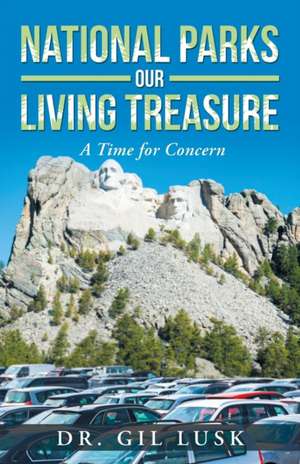National Parks Our Living National Treasures
Autor Gil Lusken Limba Engleză Paperback – 20 apr 2019
Preț: 121.32 lei
Nou
Puncte Express: 182
Preț estimativ în valută:
23.22€ • 25.23$ • 19.52£
23.22€ • 25.23$ • 19.52£
Carte disponibilă
Livrare economică 31 martie-14 aprilie
Preluare comenzi: 021 569.72.76
Specificații
ISBN-13: 9781642374971
ISBN-10: 1642374970
Pagini: 418
Dimensiuni: 140 x 216 x 25 mm
Greutate: 0.59 kg
Editura: Gatekeeper Press
ISBN-10: 1642374970
Pagini: 418
Dimensiuni: 140 x 216 x 25 mm
Greutate: 0.59 kg
Editura: Gatekeeper Press
Notă biografică
Gil Lusk is a retired National Park Service employee with 35 years of experience, mostly serving as a Superintendent of several National Parks. He served for eight years as Superintendent of Glacier National Park on the Canadian Border and five years as Superintendent of Big Bend National Park on the Mexican Border. He was the first Superintendent of Wolf Trap Farm National Park for the Performing Arts and brought it on line in 1971. He later was the first National Park Superintendent of Valley Forge National Park when it was transferred from the State of Pennsylvania to the National Park Service in 1976 in time for the Bicentennial Celebration. For his efforts he was awarded the two highest performance awards from the US Department of Interior, Meritorious Service in 1986 and Distinguished Service in 1999. The Distinquished award presented by the Secretary of Interior and the President. In 2001 his alma mater, Gettysburg College, honored him with presentation of an Honorary PhD for Public Service over four decades. He has served on the Montana Nature Conservancy Trust Board, the Sonoran Institute in Tucson, Arizona and on the Board of the Governor's Flathead Basin Commission in NW Montana and was Chair for two of his eight years on the Commission. The US Forest Service, a sister agency, because of his relationships and vision in working with the Flathead and the Lewis and Clark National Forests in Montana, selected Lusk as the first person for the Grey Towers Conservation Fellow at the Pinchot Institute in Pennsylvania in 1991. His sabbatical as a Fellow included writing about his concerns for trends that were occurring in the National Park Service along with meetings at the Yale School of Forestry and several national conservation groups in Washington, DC. The Director of the National Park Service, in 1994, asked him to spend his last few years in the Service working with employees, training centers and the Washington Office to completely rethink the training programs of the Service and establish definable career ladders for all of the various disciplines at work in the National Parks. The program as completed by the employees of the Service, would have increased our national training costs from just over 1 percent to 3 percent over an extended period of time. Among his other efforts was the stimulus for creation of the Y to Y program (Yellowstone to the Yukon), laying the foundation for others to work with Mexico in the creation of two major protected areas across from Big Bend National Park in excess of one million acres. At Glacier, he and his equal on the National Forest worked with the Burlington Northern Railroad to create the Burlington Northern Environmental Study Area, to protect Grizzly Bears and other animals from a segment of train tracks, about 14 miles long, running down from the Continental Divide down to the town of West Glacier. The concept is now called the Great Northern Environmental Study Area (GNESA) in honor of the first railroad to help establish Glacier National Park. The concept received special recognition from the Department of the Interior in 2008 as an exemplary example of collaborative conservation.
